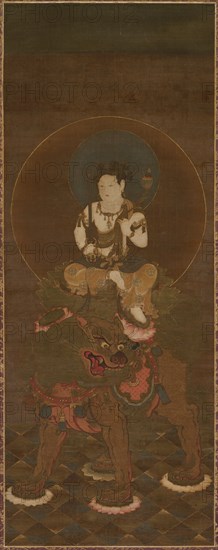
Sujet
Gokei Monju (Manjushri with Five Chignons), 1200s or 1300s. Creator: Unknown.
Légende
Gokei Monju (Manjushri with Five Chignons), 1200s or 1300s. This painting of the bodhisattva Monju, Manjushri in Sanskrit, is exemplary of the Kamakura period, known for works with special attention paid to the realism of images. Monju?s robes cling to his legs with fine ink-brush folds in a cloth patterned with gold and mineral pigment rondels. His exaggeratedly thin torso, emphasizing his muscled chest, is decorated in cloth elements with gold fasteners, done in fine ink lines and augmented with gold pigment and foil. His portrayal as a child with five hair-knots is the most commonly encountered type among Esoteric Buddhist images of Monju in Japan. Esoteric refers to religious practices that are only performed or understood by those with special knowledge shared with a limited number of advanced practitioners. Monju?s youthfulness symbolizes his pure wisdom, unsullied by the world, and his five hair-knots represent his vow to keep calamity at bay.
Crédit
Photo12/Heritage Images/Heritage Art
Notre référence
HRM19F84_204
Model release
NA
Property release
NA
Licence
Droits gérés
Format disponible
70,9Mo (7,2Mo) / 26,6cm x 66,9cm / 3138 x 7897 (300dpi)